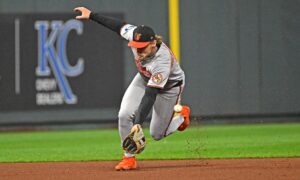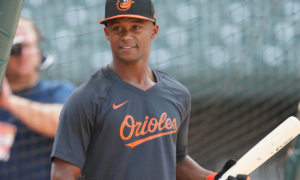SCROLL DOWN TO READ ARTICLE
First-year Orioles owner David Rubenstein answered a number of questions from BaltimoreBaseball.com’s Rich Dubroff on Tuesday. Rubenstein, whose group bought the Orioles for $1.725 billion in a sale approved in March, spoke on a number of topics, including his work ethic, his memories as a fan and his thoughts about stadium renovations. This is the second part of the conversation (Part 1 ran on Wednesday). This interview has been edited for clarity.
Question: You’re an incredibly busy person. How do you find time to own a team as well? What percent of your time is spent on the Orioles?
Rubenstein: “Everything I’m doing, I regard as something at this point in my life that I’m doing because I enjoy it, so that it’s not work. When you’re enjoying something, it’s like a hobby or a pastime. It doesn’t drain you because I’m enjoying it. Secondly, I don’t play golf. That saves about 50 hours a week, it seems, and as you may have read, I don’t drink alcohol so that saves some time, too, so I’m not going to bars or other things, and I don’t have to worry about being hung over or anything. If you’ve read about me, I’ve been more or less a workaholic much of my life. I think it was because I always wanted to achieve something in life, and I thought that if I worked harder, I would get more done than if I didn’t work hard. I didn’t have natural skills. I wasn’t brilliant. I wasn’t handsome. I wasn’t charming, all the kind of things that you might want to have to get along well in life. I didn’t have that, so I thought if I worked harder, I would be more successful than if I just relied on my good looks.”
Question: Do you remember your first game as a fan?
CONTINUE READING BELOW
Rubenstein: “I remember my father taking me to games at Memorial Stadium, and I can’t remember the exact date. I was born in 1949. I probably started going to games in 1955 or something like that when I was maybe 6 years old. I remember the Orioles, and if you have a memory of that period of time, we had some players I can still remember all their names: Gus Triandos, Jim Gentile, Gene Woodling. They were some good players that we had. I followed them like everybody else did in those days. In those days, you remember you couldn’t watch National League baseball because if you lived in Baltimore, you only saw the American League games. The only time you’d see a National League team or Willie Mays was in an All-Star Game or maybe a World Series. I remember going to Memorial Stadium, and if you know Baltimore well, if you got a letter from your mother or father to your teacher, saying Opening Day is today, and he should be excused to go to Opening Day, it is amazing how many people got those letters, how many people went to Opening Day. I went to City College, which was right across the street from Memorial Stadium. It was easy to get off, whenever midday was and go over to the Opening Day.”
Question: What was your greatest memory as a fan?
Rubenstein: “My greatest memory is that I would go into the bleacher seats and then around inning 3, I would sneak down to the mezzanine seats, and around inning 6, I would sneak down to the box seats, and around inning 7, somebody would come along and say: ‘Get out of there, you don’t belong there.’ I’ve always been afraid that that same person is going to come back now and say, ‘I told you a long time ago to get out of these seats, and you’re still in these seats.’ I remember getting kicked out of lots of seats because I didn’t have the money to buy the more expensive seats in those days.”
Question: You’ve recently hired Catie Griggs to run business operations for the team. She’ll be in charge of stadium renovations. When you look at the ballpark, what would you like to see happen?
Rubenstein: “The deal that was struck by the predecessor owner is a deal that says, in effect, for a 15-year lease, there’s $400 million. It is expected that if the ground lease is executed there will be another $200 million or so, so maybe $600 million. The stadium was built for roughly close to $110 million. If it was rebuilt today from scratch, it would probably cost between $1.2 and $1.5 billion, most people would estimate. So, we’re going to try to rehab it for roughly a cost of $600 million. It may take more. We don’t know yet. As you know, we’ve hired an architect and a contracting firm, but they haven’t come to us with detailed plans. We don’t know exactly what the cost will be. The stadium revolutionized baseball when it opened, but now that’s 30 years ago. So, what we need to do is a couple of things. Get a more up-to-date scoreboard, for example. That scoreboard, if you look at ones in other stadiums are more up to date. They can do things that ours can’t quite do. Secondly, the clubhouses are very dated compared to clubhouses in other stadiums. Three, the way the Orioles players get into the stadium is a bit complicated. If you’re a player, you drive your car in. It’s kind of like in a dungeon. You’ve got to walk through the bowels of the stadium to get to the clubhouse. There are a lot of things we can do in the bowels of the stadium that can improve it. Fan access or closer seats to the field. Those things have been talked about. Improving sightlines is something we’ve talked about as well. If you go to new stadiums, and I’ve been to a number of the visiting team’s games, you see that they have some amenities that we don’t quite have. You have to recognize, though, that you can’t quite compare Yankee Stadium with the Orioles’ stadium. In New York, there’s a wealthier client base than we have in Baltimore. Baltimore is, to some extent, a blue-collar town. It’s not New York City. It’s not Los Angeles. We can’t go ahead and build amenities that nobody will pay for. We have to be cognizant of the market in which we are operating, but I think we can make a much better stadium than we have today but, again, the bones of the stadium are reasonably good. Whether we need as many seats as we have, I don’t know. I’ll have to assess that later. How do we make the seats more comfortable? I don’t know. We’ll have to look at that. There are lots of things we can do to make it more appealing to fans. Nothing is more appealing than winning. Otherwise, if we had a bad stadium and we had a great team, people would live with that.”
CONTINUE READING BELOW
Question: Why did you hire Catie Griggs to run business operations for the team?
Rubenstein: “We interviewed many people. We had a search firm. Catie was a person who stood out among all the people we interviewed. She had the advantage of having a similar job in another city, so she wasn’t coming from another sport. Many people we interviewed were in other sports. They’d been in baseball, but they weren’t coming directly from this kind of position. She had a great reputation in Seattle. She had a real motivation to get back to the East Coast. We couldn’t find anybody to say anything negative about her. My own meetings with her were pleasant. She’s obviously smart, focused, and she seemed to have exactly the background we wanted, so we’re very excited with her.”
Question: Could you have imagined as a young man that you would have owned this team? Was this always a dream of yours?
Answer: “It’s a better story to say that it was my dream and that I’d come back to Baltimore, but to be realistic about it, when I was a boy, I didn’t know what ownership was, and I never thought that I was going to make a lot of money because making money was never my career ambition, so it never occurred to me. It wasn’t something I ever thought about. The world’s changed, so lots of people do things they didn’t expect to do. When the Orioles came to Baltimore in 1954, the purchase price was $2 million, which was hard for them to get the money to do. The price has gone up over the years, and the price we paid was a lot more than $2 million. I never would have thought as a little boy that I would have the money or the wherewithal to do something like this. It never occurred to me, no.”










